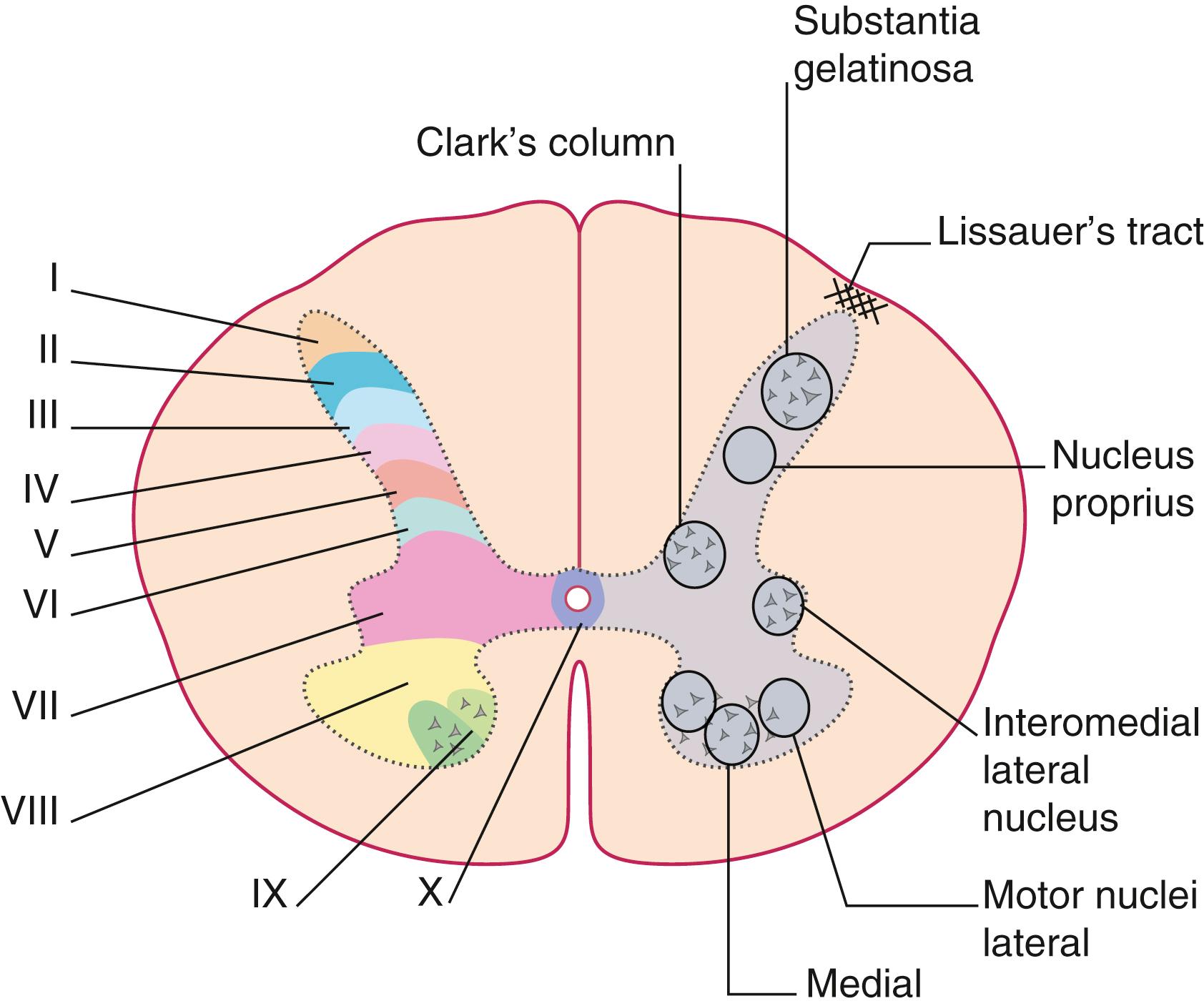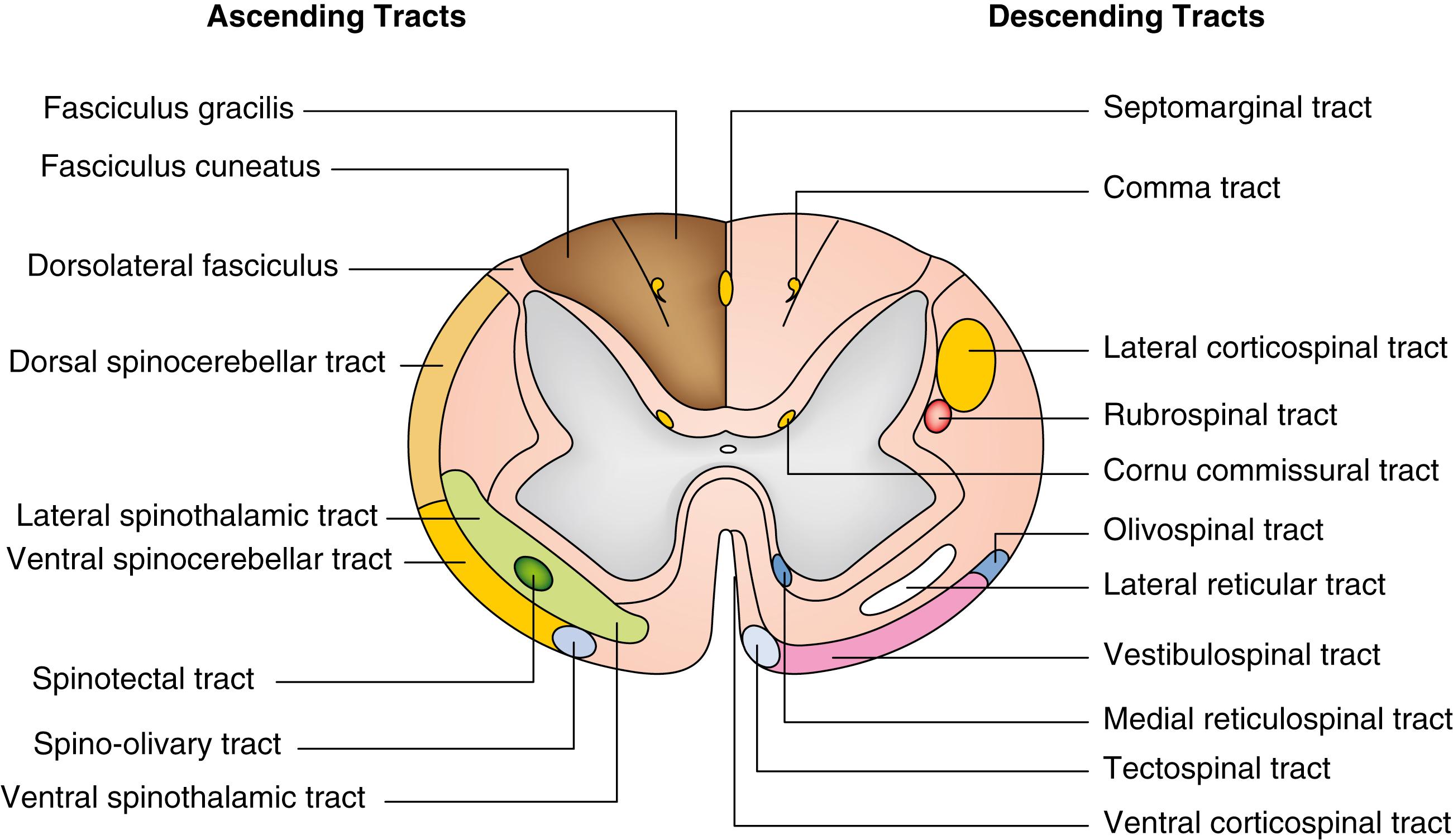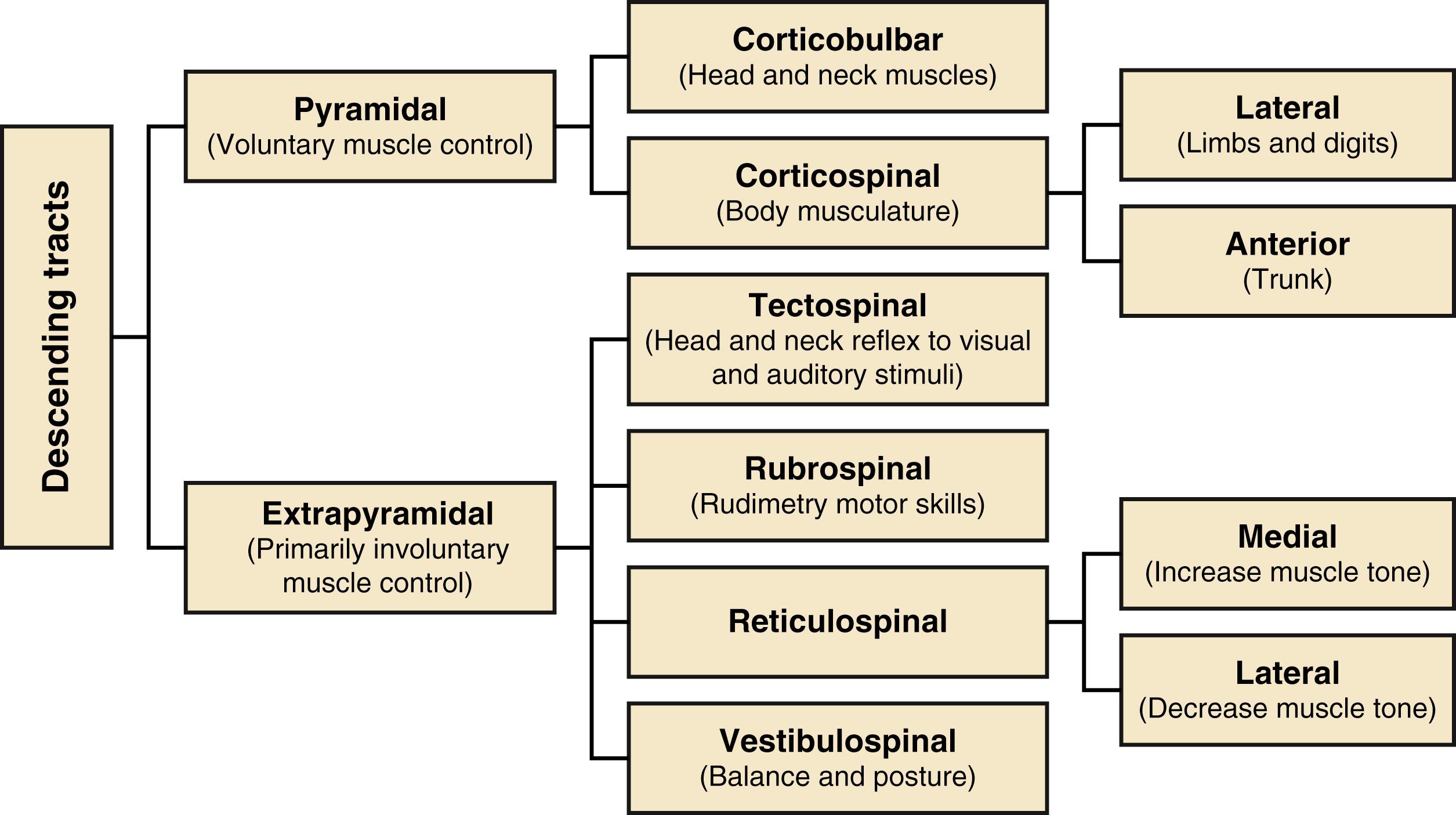Physical Address
304 North Cardinal St.
Dorchester Center, MA 02124
The spinal cord is essential in the relay, modulation, and control of neurological information to and from the periphery. An understanding of the structural anatomy of the cord will allow for the study of its function.
A spinal cord lesion can be localized, based on clinical examination and an understanding of the cord’s functional anatomy.
There are three main classifications of the spinal cord gray matter: column classification, nuclear classification, and Rexed lamina classification. The Rexed lamina classification divides the cord into 10 areas (lamina I–X) based on cellular architecture. This classification is perhaps the most useful when it comes to the study of spinal cord function. In general, laminae I to VI relate to sensation, while laminae VIII to IX are responsible for motor output.
Functionally, the descending white matter tracts can be divided into pyramidal and extrapyramidal tracts. The pyramidal tracts mainly relay voluntary muscle control to the face and body, whereas the extrapyramidal tracts are primarily responsible for autonomic and involuntary muscle control. Pyramidal tracts include the corticobulbar tract (head and neck muscles), the lateral corticospinal tract (limbs and digits), and the anterior corticospinal tract (trunk). The extrapyramidal tracts include the tectospinal tract (head and neck reflex to visual stimuli), the rubrospinal tract (rudimentary motor skills), the reticulospinal tract (muscle tone), and the vestibulospinal tract (balance and posture).
The tracts carrying conscious sensory input include the lateral spinothalamic tract for pain and temperature sensation, the anterior spinothalamic tract for crude touch and pressure sensations, and the dorsal column–medial lemniscus pathway carrying vibration, proprioception, and tactile sensations. The conscious tracts relay information from the periphery to the brain via three consecutive neurons.
Unconscious sensory information is carried via four individual tracts collectively known as the spinocerebellar tracts. These include the anterior spinocerebellar tract (for proprioception below L2), the posterior spinocerebellar tract (proprioception from L2 to T1), the cuneocerebellar tract (proprioception above T1), and the rostral spinocerebellar tract (proprioception above T1).
Central cord syndrome is a result of diffuse white matter injury to the lateral corticospinal tract, resulting in upper extremity deficits, and is not because of selective central damage to the tract, resulting in upper extremity weakness owing to somatotropic organization.
The spinal cord through the autonomic nervous system is involved in the control of cardiovascular and bladder control. The sympathetic preganglionic neurons are located in the thoracolumbar (T1–L2) region and are responsible for increasing the heart rate and cardiac contractility. For the bladder, the sympathetic system is involved in bladder filling. The parasympathetic system surrounds and has synergistic effect with the sympathetic system in the cranial and sacral segments. In the cardiovascular system, the parasympathetic system decreases cardiac output by decreasing heart rate and cardiac contractility. The parasympathetic system in the bladder is involved during bladder voiding. The location of a spinal cord lesion determines the impact of the injury to the cardiovascular and bladder control, given the differences in functional anatomy of the autonomic system throughout the spinal column.
The spinal cord also plays a role in the control of breathing via white matter tracts, prephrenic interneurons, and phrenic motor neurons. There is evidence that spinal interneurons can potentially generate respiratory drive independent of the medulla.
The spinal column encloses the spinal cord and is composed of 33 vertebrae divided into the cervical, thoracic, lumbar, sacral, and coccygeal segments. The spinal cord originates from the medulla oblongata in the brain stem and terminates in a cone shape, the conus medullaris. While the spinal cord ends at the higher lumbar regions, it is anchored to the coccyx through a nonneural filament: the filum terminale.
Spinal cord function is a vital part of the central nervous system. Understanding the functional anatomy of the spinal cord is essential in localizing diseases of the nervous system and in understanding the practical impact of spinal cord disorders.
The function of the spinal cord can be understood through the study of its major structural components, which include the ascending and descending white matter tracts and the gray matter zones. These elements of the spinal cord work together to relay motor and sensory information between the periphery and the brain, as well as to integrate local circuits that subserve breathing, bladder, sexual function, and autonomic control of essential visceral organs, including the cardiovascular system. This chapter will provide a systematic review of the critical functional anatomy of the spinal cord to enable a greater understanding of the role that this crucial part of the central nervous system plays in health and disease.
One of the main functions of the spine is to protect the neural elements and provide structural support and balance. To study the mechanical function of the spine, it is best to first break it down to a common segment. The functional spinal unit (FSU) can be defined as the smallest physiological motion unit of the spine. The FSU is composed of two adjacent vertebral columns, facet joints, an interverbal disc, and all adjoining ligaments. The bony and ligamentous anatomy of the FSU is critical in understanding the structural and biomechanical characteristics of the spine. These topics will be discussed in other chapters.
The FSU does not account for the neurological function of the spine. Whereas the anatomy of the spinal cord varies along its length, there are general similarities present at the cross sections throughout the tract. At the center is the central canal, which is a hollow tube filled with cerebrospinal fluid continuous with the ventricular system. The nerve cell bodies are in the butterfly-shaped gray matter centered around the central canal. The myelinated ascending and descending tracts form the white matter, which surrounds the grey matter. The shape and size of the grey and white matter vary along the cord. The amount of white matter decreases moving from rostral to caudal owing to fewer ascending and descending tracts. The cervical and lumbar regions have more gray matter because of the presence of motor and sensory neurons that are supplying the limbs.
The external surface of the cord is delineated by longitudinal sulci and fissures. The anterolateral sulcus is the exit point of roots carrying motor information. The posterolateral sulcus is the entry point of roots carrying sensory information.
There are several functional classifications of the gray matter, which are based on the columns, on the nuclei, and on the cellular structure (Rexed lamina classification) ( Fig. 11.1 ).

In the column classification, the gray matter is divided into four regions: posterior (dorsal) column, intermediate column, lateral column, and anterior (ventral) horn. The posterior (dorsal) column receives somatosensory information from the body and relays this information rostrally via ascending tracts. The anterior (ventral) horn houses mainly motor neurons, which innervate skeletal muscles. The intermediate and lateral columns supply the pelvic and visceral organs.
In the nuclear classification, prominent groups of neuron cell bodies are grouped into six categories based on location. The marginal zone (posterior marginalis) is a thin layer at the tip of the dorsal horn. The marginal zone contributes to the lateral spinothalamic tract, transmitting ascending pain and temperature information to the diencephalon. The substantia gelatinosa is at the cap of the top of the dorsal horn. The substantia gelatinosa is essential in pain, temperature, and light touch sensation. The nucleus proprius is at the neck of the dorsal horn below the substantia gelatinosa. This group of neurons relays both temperature and mechanical information. The nucleus proprius has projections to the cerebellum via the spinocerebellar tract and to the thalamus via the spinothalamic tract. The dorsal nucleus of Clarke is in the medial aspect of the dorsal horn, is only found in segments C8 to L3, and is most prominent in the lower thoracic and lumbar segments. This group of nuclei relays unconscious proprioceptive information to the cerebellum via the spinocerebellar tract. The intermediolateral nucleus is in the lateral horn and intermediate columns. The intermediolateral nucleus sends viscerosensory information. In C8 to L3, the intermediolateral nucleus axon projections form the sympathetic tract as preganglionic fibers, and at S2-4 they form the preganglionic parasympathetic neurons. The lateral motor neurons and medial motor neurons are located in the ventral horn. They innervate skeletal and visceral muscles.
The Rexed laminar classification was developed in the 1950s by the Swedish anatomist Bror Rexed, who discovered that the distribution of cells within the gray matter of the spinal cord relates to the cytoarchitecture of the cells, specifically with lamination patterns. The Rexed lamina classification partitions the gray matter into 10 segments, based on differences in cellular structure. The nuclear and Rexed lamina classifications can be connected based on anatomical location. It can be argued that the Rexed lamina system better reflects the function of the cord by providing further granularity. Each of the 10 Rexed laminae has a distinct function, as summarized in Table 11.1 . In general, laminae I to VI relate to sensation, whereas laminae VIII to IX are responsible for motor output. Rexed lamina II is of particular importance when it comes to pain, as it acts as the main area for pain modulation with high concentrations of opiate receptors and substance P.
| Lamina | Location | Main Function |
|---|---|---|
| I | Posteromarginal nucleus | Thermal and noxious stimuli |
| II | Substantia gelatinosa | Modulation of sensory input |
| III | Nucleus proprius | Proprioception and light touch Interneurons with laminae IV–VI |
| IV | Nucleus proprius | Nonnoxious sensory input. Interneurons with lamina II |
| V | Nucleus dorsalis | Nociceptive sensation from visceral organs Predominantly involved in the ascending spinothalamic tract |
| VI | Nucleus dorsalis | Spinal reflexes Ascending information via the spinocerebellar pathways |
| VII | Intermediolateral cell column, intermediate gray matter, intermediomedial cell column | Autonomic system Motor output to visceral organs |
| VIII | Anterior fasciculus | Modulating output to skeletal muscles |
| IX | Anterior horn | Innervate skeletal muscle |
| X | The perimeter of central canal | Decussation of axons |
Unlike in the brain, the gray matter in the spinal cord is surrounded by white matter. White matter tracts can be viewed as the information “highway” of the central nervous system. Understanding the functional anatomy of the white matter tracts is essential in clinical practice, as this allows for localization and diagnosis based on clinical symptoms and physical examinations. White matter is composed of mainly myelinated nerve fibers that carry information from the brain to the body (descending) or from the body to the brain (ascending). The location and structure of these tracts are summarized in Fig. 11.2 .

The descending tracts relay motor signals from the brain stem or cerebral cortex to the periphery. The descending tracts are composed of upper motor neurons terminating at their respective lower motor neurons, with no upstream synapses. Functionally, the descending tracts can be divided into pyramidal and extrapyramidal tracts. The pyramidal tracts relay voluntary muscle control to the face and body, whereas the extrapyramidal tracts are primarily responsible for autonomic and involuntary muscle control. A brief hierarchical overview of the descending tracts and their function is provided in Fig. 11.3 .

The pyramidal tracts can be further subdivided into the corticospinal and corticobulbar tracts based on their area of innervation. The corticospinal tracts innervate the muscles of the body, whereas the corticobulbar tracts supply the facial and neck muscles. These two pathways form the pyramids at the medulla; hence the term pyramidal in their classification.
The corticospinal tracts originate at the cerebral cortex, passing through the corona radiata through the posterior limb of the internal capsule and then to the crus cerebri of the midbrain into the medulla. Approximately 60% of the input for the corticospinal tract is from the motor and premotor and motor cortices, with the remaining 40% being from the somatosensory cortex, cingulate gyrus, and parietal lobe. Within the medulla, the majority (90%) of the fibers decussate (cross over) in the pyramids of the lower medulla before descending down the spinal cord in the ventral horn, forming the lateral corticospinal tract. The remaining 10% of fibers form the anterior corticospinal tract, descending down the cord close to the anterior median fissure and decussating in the spinal cord at the level they innervate.
The primary function of the lateral corticospinal tract is to initiate and modulate voluntary motor movement of the limbs and the digits, especially fine motor movements and control of the upper extremities. The anterior corticospinal tract is mainly involved in control of the trunk and axial muscles. The cortical innervation of both the anterior and lateral corticospinal tracts is contralateral. However, given the pyramidal decussation of the lateral corticospinal tract, lesions caudal to the pyramidal decussation will result in ipsilateral deficits, whereas lesions rostral to the decussation will result in contralateral deficits.
The corticobulbar tract originates at the primary motor cortex, traveling through the corona radiate and through the genu of the internal capsule—the upper motor neurons synapse with the cranial nerve lower motor neurons at the level of the brainstem. Unlike the corticospinal tract, the corticobulbar tract does not descend down the spinal cord.
Become a Clinical Tree membership for Full access and enjoy Unlimited articles
If you are a member. Log in here